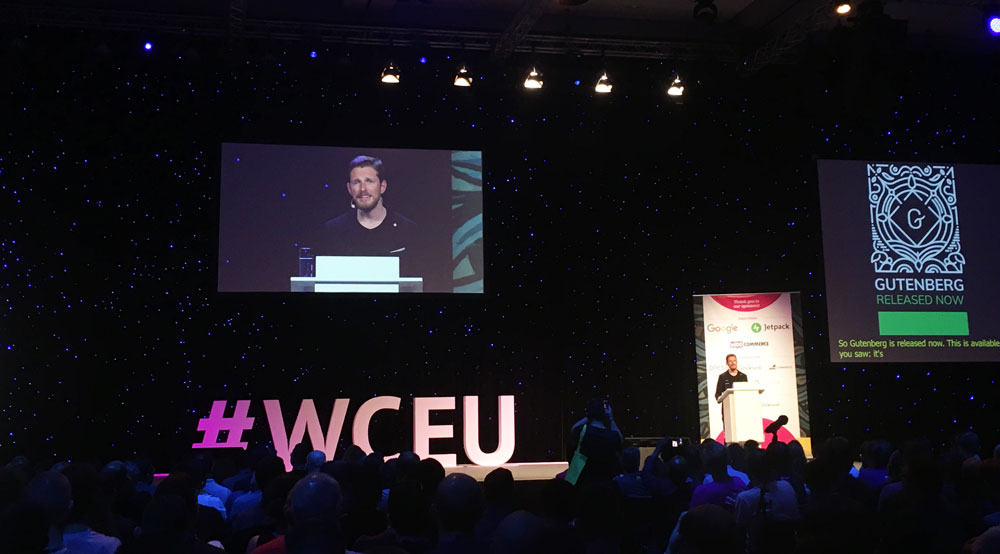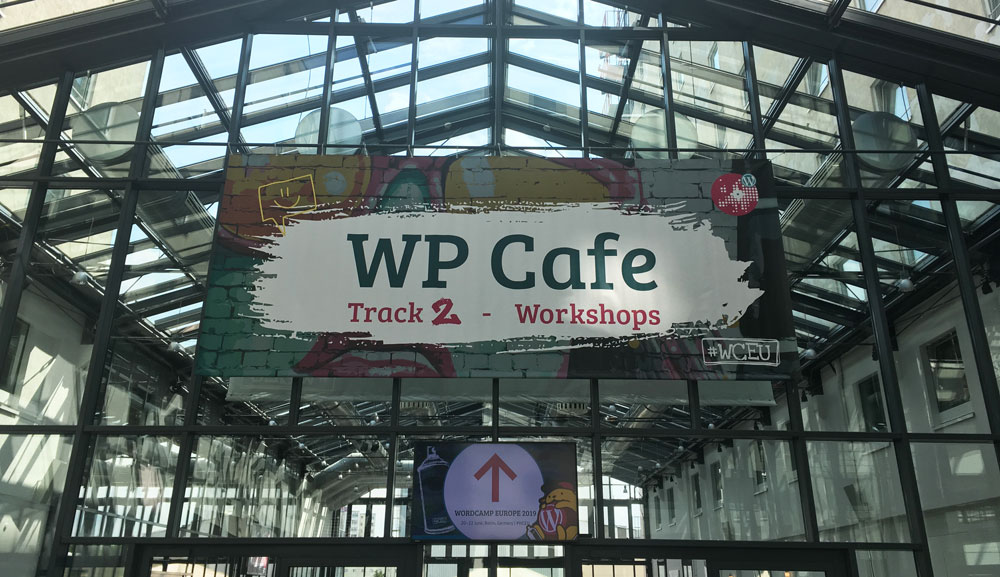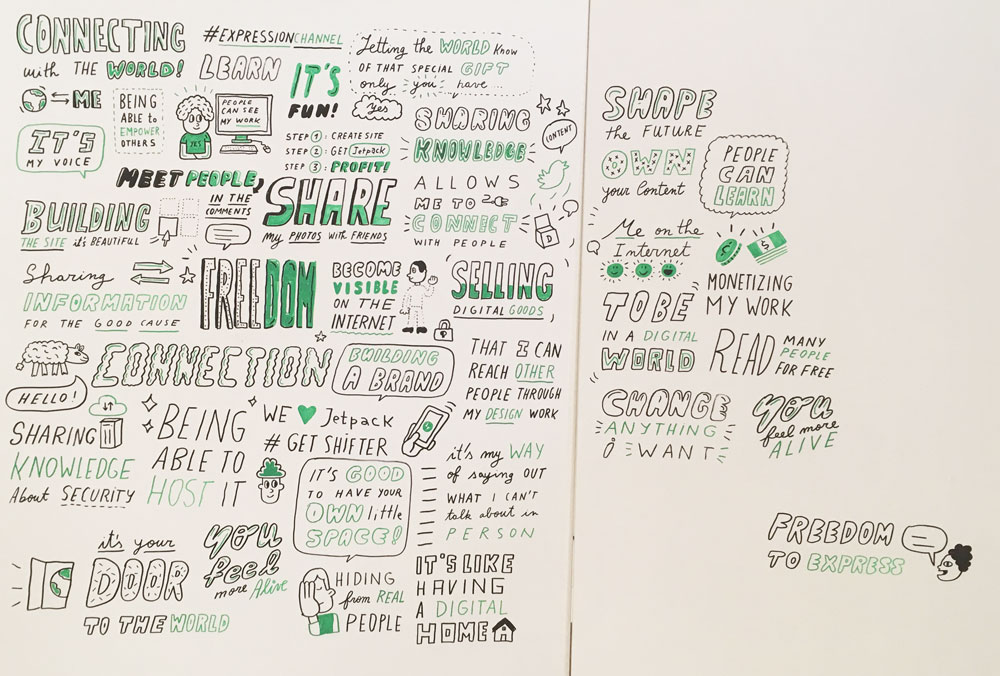WordCamp Europe 2019 just ended and like in 2016 and 2017, I was there. Additionally, as in those times, I decided to write a report for those who couldn’t make it.
This year, WCEU took place in Berlin in the Estrel Hotel from June 20 to June 22. I live in Berlin, so it was very easy to get to and from the venue.
More than 3,600 people bought tickets, which is 800 more than last year. This makes WCEU 2019 the largest WordCamp to date. More than half of the attendants were first-timers. The Contributor Day on Thursday was also fully booked.
Presentations were organized into three tracks, plus three workshop tiers. The latter were, as I had to find out on the first day, sold out quickly. In addition, attendants could find offers for mindfulness and yoga.
Below you can find notes from some of my favorite talks and presentations. You can find these, and the rest, also as part of the archived live streams on YouTube.
Let’s take it away.
Change Your Socks, Change Your Mind: A No-fuss Primer on Change Management
The first talk I attended was by Josepha Haden, executive director of WordPress, and it was on change management.
Why Change is Hard
In the first part, she talked about why it is hard to introduce change in any organization. All three are (admittedly) a bit paradoxical.
- Human nature — We as human beings are averse to change, loss, risk, and like to do things that we know will be successful. This extends to communities. The more connected a community is, the more resistant it is to change. Yet, at the same time, the more connected you are, the more likely it is you will get the change through.
- Poor planning — People in leadership roles don’t always create good plans. There can be too much planning, resulting in rigidity or too little, which fails to give direction.
- Lost leadership — You need to have a plan, you need to have a vision and you need to remind people of it. At the same time, you also need to listen to your people and be decisive but not too decisive.
How to Support Changes in Your Organization
In the next part, Josepha mentioned what you can do in order to help make change happen in your company or organization.
- Don’t confuse communication with engagement — Don’t assume everyone else has the same knowledge you have. Lack of feedback is a sign of unhealthy communities and organizations. If you are communicating but don’t get feedback, that’s a problem.
- Tell the story of what is inspiring about the change — Don’t assume that what is motivating you is also motivating others. Make sure to tell the story of what you are hoping to achieve.
- Define what you can and don’t fear the undefined — Be comfortable with being uncomfortable. We all should have strong opinions loosely held. If confronted with a strong argument, be open to change.
- Don’t go alone — It’s not the leader’s sole responsibility to get from A to B. Get team support.
Big Things for Big Change
The presentation finished with some basic tactical information on how to manage change and the different stages you will encounter.
- Plan and align — This part belongs entirely to top-down management. What do you aspire to change with this change? Make sure you have set the goal for how you want to make things different. Management is easy, inspiration is hard.
- Leaving point A — This part shouldn’t be too difficult if you have done the first part well. Be sure to explain why you need to leave point A and what the risks are in staying there. Be sure to honor the work and people that got you there.
- Wander through the unknown — This part is the most uncomfortable, so you have to get ready for it.
- Finding point B — There are different theories whether you should know exactly or only kind of where you are going. Be sure to celebrate your successes, write down what you did right. Also, celebrate your failures, use them as opportunities for the future.
- Rinse and repeat — Start from the top but commit to listening to feedback.
Matt on WordPress
One of the highlights of every WordCamp Europe is the keynote by Matt Mullenweg. At WCEU he gives what he calls the “summer update”. This year, because of current events, it focused mainly on Gutenberg.

Gutenberg Update
Matt started with a summary of the completed Gutenberg phase 1. By now, more than 150,000 posts are published with the new block editor every day.
Currently, we are in phase 2, which focuses on widgets, navigation, customization. After that comes phase 3. It will deal with collaboration, multi-user editing, and workflows. Phase 4 then will introduce multilingual support.
The Gutenberg plugin is also still active and used to test new features. Here are some recent updates:
- The ability to hide or show different blocks via the block manager
- A cover block with nesting elements
- Using pre-existing widgets inside the Gutenberg editor
- Block grouping
- Nesting and columns — blocks within blocks
- Snackbar notifications
He finished with examples of cool uses of Gutenberg in the wild. Among others, 19 out of 21 Democratic candidates are using WordPress for their web presences. In addition, whitehouse.gov also switched to WordPress this year.
What is Coming to Gutenberg Soon?
In the next part, he also talked about what we can expect in the block editor in the near future. These include:
- The ability to install new blocks in Gutenberg inline
- A block directory that could become a new top-level menu item in WordPress and provide education and management
- Navigation blocks that you can put any place you like
Here are also some experiments that they are trying out:
- Motion animation for moving blocks
- Footnotes
- Resizing images via grid
Q&A Session
As usual, a Q&A session followed the keynote presentation. Questions were on various topics. Here some of the most important ones, plus Matt’s replies:
When will a democratic structure and an
open transparent decision-making process be implement on WordPress.org?
We try to get a sense for common issues, for example, by doing polls and surveys. We try to get informed by what the community needs and make decisions from there. The decision-making process is basically transparent and visible on Trac. Only small parts are not transparent like security. Apart from that, there are tons of feedback channels.
How are the Gutenberg accessibility problems going to be addressed?
It’s a work in progress and we can always be better. The audit was great and we working down that list. Accessibility is hard but we will get there. Every release will be better.
How do you plan to balance front end changes with back end code legacy, etc.?
PHP will continue to be crucial for years. However, we have fallen behind in this area. The triage team could do more. The biggest issue here is backlog. It’s a ripe area for contributions. He will talk about that in the state of the word.
Other inquiries were on WordPress and Envato, paid directories, the future of themes in times of a block editor, using Github instead of Trac for development, WordPress and Blockchain, the future of the REST API, raising the PHP version for plugins and more engagement of the WordPress foundation in Brazil.
SEO Copywriting – Workshop

On the second day, I managed to snag one of the coveted workshop tickets. It was led by Jesse van de Hulsbeek of Team Yoast and lead at Yoast Academy.
SEO Copywriting Quiz
The workshop started off with a quiz that participants answered. It consisted of several questions on how Google works and other topics. After each question, we talked about the topic.
- Does Google understand your text? — Under cloud.google.com/natural-language, you can find a demo for how Google determines the topic and sentiment of content. We looked at it with some examples to see how accurate it is. The results can be mixed based on different types of text.
- You can make copy more accessible to Google with code that describes types of content — That is true, it’s called structured data. You can use it to show Google what content is about. Something that is usually difficult to understand for machines can be made more understandable this way.
- If your audience is smart, readability is not really an issue — False, readability is always important. Making your text easy to read always matters to not overload readers. When they are using too much energy trying to decipher your text, they are missing the message. Readability is one of the most important aspects of copywriting.
- SEO copywriting is completely different from “standard” online writing — Most of the principles you can apply to online writing you can apply to SEO copywriting. The writing is the most important part. Being a good writer helps you be an SEO copywriter.
- A good writer is a good SEO writer — Not true. For examples, Hemingway would not have been a good SEO copywriter.
Worksheets
After that, we were split into three groups according to writing skills and SEO knowledge. The organizers shared a handout that we were supposed to work through on our own to improve both text structure and SEO optimization of our posts. Here are the contents:
- Preparation
- Pick a keyphrase
- Decide on the angle of the blog post
- Write down the main message
- Write down a description of the desired audience
- List topics and things you would like to address
- Bundle topics
- Order topics
- Determine the text structure
- Writing
- Write the core sentence of your paragraphs
- Complete the paragraphs
- Insert headings and subheadings
- Write a meta description
- Editing
- Check for transition words
- Check sentence length
- Look at each paragraph for structure
- Examine the overall text structure
- Check for SEO markers
This was emphasized by additional handouts which discussed the points raised for text structure and optimization in detail and gave additional tips on how to get them right. Unfortunately, they don’t exist as PDFs, so I can’t link to them right now.
The rest of the workshop was spent writing or working on pieces that each person wanted to improve or produce.
Reduce, Reuse, and Recycle – 7 Ways to Re-purpose Content and Maximize Your Efforts
This talk was given by Yvette Sonneveld from Level Level. You can find the slides, a video of the talk, examples and more on their website.
The Purpose of Re-purposing Content
Re-purposing content means presenting what you already have in a different way. This achieves several outcomes:
- Help your audience remember what’s important
- Meet them where they are by offering content on a variety of levels and in different mediums and websites
- Keep their preferences in mind, by offering content in different formats (visual, text, assignments, etc.)
- Keep content up to date so that your audience doesn’t deal with out-of-date information
- Share your expertise wherever you can, such as on social media, guest sites, magazines and more

Main Strategies for Re-purposing Content
Here are ways to achieve the above:
- Do a seasonal cleanup — Regularly go through your content and update the information, keywords, etc. If it’s too much, divide it by topic or some other metric. Start with the most popular ones. Include a last-updated date. Do the same for e-books and white papers.
- Content splintering — Chop up content into smaller, more focused pieces. Connect pieces logically. For example, you can turn white paper chapters into blog posts, use quotes from these posts for social updates or turn presentation slides into posts and social messages.
- Content stacking — Stack several pieces of short-form content into a longer piece. Examples: crowdsource blog posts or turn blog posts into e-books and white papers.
- Media swap — Turn your content into other forms. Presentations into blog posts or blog posts into video tutorials. You can also offer content upgrades like a checklist, planner or template.
- KonMari your content — Which pieces give joy? Check your analytics to find out. Take important information from unpopular blog posts and add them to another, then redirect the original post to the new one. This is also called content pruning.
- Re-purpose with purpose — Make sure you know what you’re working towards. Plan for the types of steps you want your visitors to take and align your content with the customer journey.
Conclusion
And that’s it. Another year of WordCamp Europe done. New lessons learned, new people met, a new report written.
At this point, thanks again to the many people who worked hard to make it possible. All the volunteers, organizers, speakers and everyone else involved.
Thanks also to the guys from Wildheart Media and Make It Red who were my trusty WordCamp companions this year.
If you have never been to WordCamp Europe, you will have your chance next year when it will be in Porto, Portugal. Hope to see you there!
Did you go to WordCamp Europe 2019? What was your favorite session? Anything else to say? Let us know in the comments section below.
The post A Report from WordCamp Europe 2019 – Making History in Berlin appeared first on Torque.
